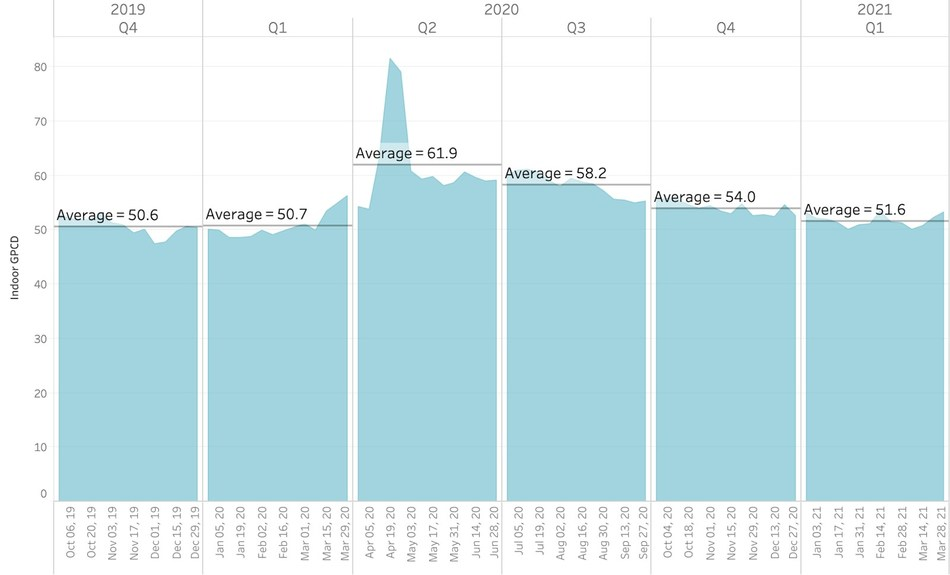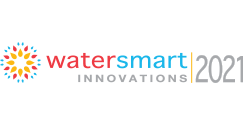Water Efficiency Watch – May 2021
Published: May 18, 2021
In this issue of Water Efficiency Watch:
- American West Prepares for Drought
- Water Data Breakthrough – Flume Introduces Quarterly Household Water Use Index
- Promising Water Investments in Proposed Infrastructure Bill
- AWE Launches First-Ever Cooling Tower Estimating Model
- A Review of Connection Fees and Service Charges by Meter Size
- Next Generation Water Summit
- AWWA ACE
- California Peer to Peer Conference
- WaterSmart Innovations
- News in Brief
American West Prepares for Drought
 AWE is closely monitoring the unprecedented drought
AWE is closely monitoring the unprecedented drought ![]() that will affect much of the west this summer. Are you looking to design and implement outdoor water savings programs to help conserve water in your service area? The Alliance is here to help! Check out the Landscape, Irrigation and Outdoor Water Use section of AWE's online resource library for the most cutting-edge information on sustainable and native landscaping, drip irrigation, smart irrigation controllers, and much more. Additionally, AWE's multi-part outdoor water savings research produced three groundbreaking reports:
that will affect much of the west this summer. Are you looking to design and implement outdoor water savings programs to help conserve water in your service area? The Alliance is here to help! Check out the Landscape, Irrigation and Outdoor Water Use section of AWE's online resource library for the most cutting-edge information on sustainable and native landscaping, drip irrigation, smart irrigation controllers, and much more. Additionally, AWE's multi-part outdoor water savings research produced three groundbreaking reports:
- The Peak Day Water Demand Management Study explores the viability of using remotely-controlled irrigation systems to reduce peak water demands and introduces a promising new approach.
- The Landscape Transformation Study and related Sustainable Landscapes: a Utility Program Guide, help water utilities establish programs that incentivize homeowners to upgrade their lawns to water efficient landscaping.
- Use and Effectiveness of Municipal Irrigation Restrictions During Drought explores how different levels of mandatory and voluntary restrictions can achieve demand reduction, and how various messaging and enforcement strategies influence the efficacy.
Remember that most of this content is available to members only, so make sure you are signed in to access these great resources.
AWE Drought Webinar
Register today for an AWE/CalWEP webinar on Preparing for Drought. The webinar will provide an overview of AWE’s drought planning resources, CalWEP’s Water Shortage Tool Kit, and AWE’s Drought Restrictions Study. The webinar will also feature AWE utility members, California Water Service and Salt Lake City Public Utilities, presenting case studies with lessons learned. Join us May 25 at 1 p.m. CDT for this not-to-be-missed webinar.
Water Data Breakthrough – Flume Introduces Quarterly Household Water Use Index
by Peter Mayer, P.E., Principal, WaterDM, Editor Emeritus of Water Efficiency Watch (2007-2019)
Residential water demand is the dominant use category for most water utilities in America. Understanding where and how residents use water is critical for water providers to understand for multiple purposes within the organization including planning, rates, and demand management. For more than twenty-years the Residential End Uses of Water studies published by the Water Research Foundation have provided a foundation for understanding residential water demand patterns in the US and Canada. I was the co-principal investigator of these studies and I can attest to the intense level of effort that it took to collect, analyze, and report on water use in 1,188 homes (REUWS 1) and 762 homes (REUWS 2), which were published 17 years apart.
Last month I helped introduce the Flume Household Water Use Index for Q1 2021 ![]() and to present residential water use from the largest metropolitan areas in the US. It is difficult to understate the leap forward that has occurred with the publication of this index which includes data analyzed from tens of thousands of Flume devices across the US. The figure below shows indoor gallons per capita per day from all Flume devices installed in the US.
and to present residential water use from the largest metropolitan areas in the US. It is difficult to understate the leap forward that has occurred with the publication of this index which includes data analyzed from tens of thousands of Flume devices across the US. The figure below shows indoor gallons per capita per day from all Flume devices installed in the US.
In Q4 2019 (prior to COVID-19) the indoor Flume Household Water Use Index was 50.6 GPCD. During the peak of COVID-19 (Q2 2020), the indoor Flume Index peaked at an average of 61.9 GPCD. During this quarter, indoor water averaged as high as 81.5 GPCD during the week of April 19, 2020. Since then, the indoor Flume Index has steadily declined through Q1 2021, correlating with businesses across the country reopening. However, indoor water use is still about 1.0 GPCD higher in Q1 2021 than it was in Q4 2019.
 What is perhaps most remarkable is that the Flume Index will be produced every quarter from now on. No more 17-year waits between end use studies. The Flume Household Water Use Index will be presented every quarter. The Q2 index, scheduled for July 2021, will feature an analysis of leakage in homes across the US in addition to regular reporting on indoor per capita use and outdoor per household use.
What is perhaps most remarkable is that the Flume Index will be produced every quarter from now on. No more 17-year waits between end use studies. The Flume Household Water Use Index will be presented every quarter. The Q2 index, scheduled for July 2021, will feature an analysis of leakage in homes across the US in addition to regular reporting on indoor per capita use and outdoor per household use.
I've spent my career working closely with water providers to understand how water is used so that it can be managed and conserved more effectively. The Flume Household Water Use Index is a significant breakthrough in the measurement, analysis, and presentation of residential demand information, and it's only just the beginning. As more Flume devices are installed every day across the US the data set grows and the ability to understand demand trends improves. Look out for an upcoming announcement about the date of the Q2 2021 Flume Household Water Use Index webinar.
Promising Water Investments in Proposed Infrastructure Bill
 The White House announced its American Jobs Plan with a focus on economic development and job creation through infrastructure investment. AWE and its member organizations are currently working with congress and Biden administration officials to ensure funding for water-efficient infrastructure and products are included.
The White House announced its American Jobs Plan with a focus on economic development and job creation through infrastructure investment. AWE and its member organizations are currently working with congress and Biden administration officials to ensure funding for water-efficient infrastructure and products are included.
A new poll by the Value of Water Campaign ![]() shows that 78% of voters support federal investment in water infrastructure. For the sixth year in a row, the Value of Water Campaign conducted a bipartisan survey asking over 1,000 Americans to rate their support on various water issues. The poll found:
shows that 78% of voters support federal investment in water infrastructure. For the sixth year in a row, the Value of Water Campaign conducted a bipartisan survey asking over 1,000 Americans to rate their support on various water issues. The poll found:
- 71 percent of respondents support ensuring that the water and wastewater sector receive federal COVID-19 relief in proportion to that of other infrastructure sectors.
- Nearly four in five Americans say they trust that the water delivered to their home is safe (78 percent).
- Similarly, four in five Americans trust that the water pipes in their homes are safe (80 percent).
- Voters feel very positively about their local water infrastructure, with 79 percent of all respondents rating their local water infrastructure as somewhat or very good.
- 62 percent of voters support a $1.2 trillion upgrade to water and wastewater systems. That percentage climbs to 69 percent when voters are given more information about the state of the nation’s water infrastructure and the need for investment.
- Voters are highly satisfied with their water and wastewater service (85 percent). As in the past, voters are highly satisfied with their water, wastewater and stormwater service, view it as affordable, and trust that the water delivered to their home is safe.
Fortunately, the American Jobs Plan includes a number of investments to maintain and improve the country’s water infrastructure, including:
- $56 billion in grants and low-cost flexible loans to states, Tribes, territories, and disadvantaged communities to modernize drinking water, wastewater, and stormwater systems in rural communities.
- $213 billion to build and retrofit more than two million affordable and sustainable homes and $100 billion to upgrade and build public schools. AWE will advocate for the inclusion of plumbing system repair, water-efficient fixture and appliance upgrades, and water-efficient landscape design and efficient irrigation products in these proposed programs.
- $46 billion worth of clean energy products purchased by the federal government. AWE encourages the administration to include energy-efficient products that use water in this initiative, such as WaterSense-labeled faucets and showerheads and ENERGY STAR® clothes washers and dishwashers.
AWE Launches First-Ever Cooling Tower Estimating Model
 AWE's recently-released Cooling Tower Estimating Model (CTEM) and the accompanying guide titled, Taking Inventory: A Guide for Identifying Cooling Towers and Estimating Water Use, is a ground-breaking innovation in cooling tower water efficiency. This first-of-its-kind model is an Excel-based tool that provides an estimated range of the number of water-cooled facilities, number of cooling towers, total cooling capacity, water use, and water conservation potential for a utility service area based on a minimal amount of input data.
AWE's recently-released Cooling Tower Estimating Model (CTEM) and the accompanying guide titled, Taking Inventory: A Guide for Identifying Cooling Towers and Estimating Water Use, is a ground-breaking innovation in cooling tower water efficiency. This first-of-its-kind model is an Excel-based tool that provides an estimated range of the number of water-cooled facilities, number of cooling towers, total cooling capacity, water use, and water conservation potential for a utility service area based on a minimal amount of input data.
A Review of Connection Fees and Service Charges by Meter Size
 AWE recently released a report that evaluates connection fees and service charges by meter size for 50 communities in the United States. The main purpose of this research was to explore connection fees and recurring charges that vary by meter size, and the potential financial implications for water utilities that would be associated with a possible trend in downsizing the meter sizes of new connections. This work was prompted by recent innovations in pipe-sizing methodologies and the increased interest in right-sizing plumbing systems, along with the potential efficiency and conservation impacts that may result from these changes.
AWE recently released a report that evaluates connection fees and service charges by meter size for 50 communities in the United States. The main purpose of this research was to explore connection fees and recurring charges that vary by meter size, and the potential financial implications for water utilities that would be associated with a possible trend in downsizing the meter sizes of new connections. This work was prompted by recent innovations in pipe-sizing methodologies and the increased interest in right-sizing plumbing systems, along with the potential efficiency and conservation impacts that may result from these changes.
WaterSmart Innovations
 The WaterSmart Innovations Conference and Exposition (WSI) is the largest urban water-efficiency conference of its kind in the world. Presented by the Southern Nevada Water Authority, AWE, and numerous other forward-thinking organizations, WSI is recognized as the world's pre-eminent urban water efficiency conference. Join us October 6-7 in Las Vegas for this exciting gathering of water efficiency professionals. Click here
The WaterSmart Innovations Conference and Exposition (WSI) is the largest urban water-efficiency conference of its kind in the world. Presented by the Southern Nevada Water Authority, AWE, and numerous other forward-thinking organizations, WSI is recognized as the world's pre-eminent urban water efficiency conference. Join us October 6-7 in Las Vegas for this exciting gathering of water efficiency professionals. Click here ![]() to learn more.
to learn more.
On October 5, the day before the conference officially begins, AWE will hold our Annual Member Meeting and in-person meetings for our three advisory committees. We hope to see you there!
Next Generation Water Summit
 Register today for The Next Generation Water Summit, an annual conference bringing together the building and development community, water reuse professionals, and water policymakers in a collaborative setting. This year's summit will be held virtually from June 2-4, 2021. Don't miss this opportunity to share best practices and learn about innovative water conservation and water reuse techniques. AWE's Director of Programs, Bill Christiansen, will be one of the speakers, alongside numerous AWE members and partners. Click here
Register today for The Next Generation Water Summit, an annual conference bringing together the building and development community, water reuse professionals, and water policymakers in a collaborative setting. This year's summit will be held virtually from June 2-4, 2021. Don't miss this opportunity to share best practices and learn about innovative water conservation and water reuse techniques. AWE's Director of Programs, Bill Christiansen, will be one of the speakers, alongside numerous AWE members and partners. Click here ![]() to learn more and to register for the summit.
to learn more and to register for the summit.
AWWA ACE
Register today for the American Water Works Association Virtual ACE21, to be held June 14-17. The program will feature more than 80 hours of learning in six professional tracks. Access presenters and peers through real-time interactive Q&A sessions and discussions. Sessions will be available to review on-demand for 30 days after the event. Click here ![]() to learn more and to register.
to learn more and to register.
California Peer to Peer Conference
 Early bird pricing ends May 26 for the California Water Efficiency Partnership (CalWEP) Peer to Peer 2021, which will be held virtually June 2-3. The 5th Annual Peer to Peer will give water professionals an opportunity to connect, collaborate, and grow. From webinars where you can earn CEUs, to peer-designed and peer-run workshops, this not-to-be missed conference will combine high-quality content and easy-to-access digital engagement to AWE/CalWEP members and partners. Register early to save $50! Click here
Early bird pricing ends May 26 for the California Water Efficiency Partnership (CalWEP) Peer to Peer 2021, which will be held virtually June 2-3. The 5th Annual Peer to Peer will give water professionals an opportunity to connect, collaborate, and grow. From webinars where you can earn CEUs, to peer-designed and peer-run workshops, this not-to-be missed conference will combine high-quality content and easy-to-access digital engagement to AWE/CalWEP members and partners. Register early to save $50! Click here ![]() to view the full agenda and to register.
to view the full agenda and to register.
News in Brief
There’s No Place for Waste, a Message from Whirlpool Corp’s Sustainability Lead (and AWE Vice Board Chair). View the message here. ![]() .
.
Las Vegas pushes to become the first to ban ornamental grass in water conservation move. Learn more here ![]() .
.
AWE Partner Metrus Energy named Leading Contender in Energy-as-a-Service Market by Guidehouse Insights. Learn more here ![]() .
.
Sandra Postel wins Stockholm Water Prize. Learn more here ![]() .
.
The Authority Podcast: Plumbing and Mechanical (featuring former AWE President and CEO, Mary Ann Dickinson). Learn more here ![]() .
.

